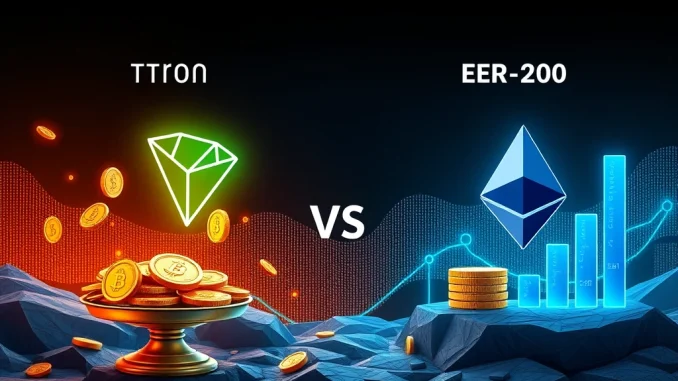
The cryptocurrency landscape is constantly evolving, and a significant shift just occurred that has captured the attention of market observers. For the first time in history, the total supply of TRON USDT (USDT issued on the TRON network using the TRC-20 standard) has officially surpassed the supply of Ethereum USDT (USDT on the Ethereum network using the ERC-20 standard).
According to data highlighted by crypto market analyst Maartunn, cited by CryptoQuant on X, the USDT supply on TRON reached an impressive $73.8 billion. This figure now stands ahead of the $71.9 billion supply residing on the Ethereum network. This development is more than just a number; it signals a change in user preference and network activity for the world’s most widely used stablecoin.
Why is TRON USDT Overtaking Ethereum USDT?
The primary drivers behind this shift boil down to practical advantages for users transferring value. The TRON network is known for its significantly lower transaction fees and faster confirmation times compared to Ethereum, especially during periods of high network congestion.
For many users, particularly those frequently moving USDT between exchanges, using TRC-20 tokens means paying fractions of a cent per transaction, as opposed to potentially several dollars or even tens of dollars for an ERC-20 transaction on Ethereum’s mainnet. This cost efficiency makes TRON a more attractive option for simple transfers and remittances.
Understanding the Growth of USDT Supply on TRC-20 and ERC-20
Ethereum was the initial dominant platform for USDT due to its early lead in smart contract functionality and the growth of DeFi. The ERC-20 standard became the default for many tokens, including USDT.
However, TRON actively pursued stablecoin adoption, promoting its network’s capabilities for fast, cheap transactions. Over time, major cryptocurrency exchanges increasingly supported TRC-20 deposits and withdrawals, making it easy for users to choose the cheaper network. This consistent support and the inherent cost advantage gradually chipped away at Ethereum’s dominance in terms of raw USDT supply.
What are the Key Differences Between TRC-20 and ERC-20?
While both represent the same asset (Tether’s USDT), their underlying network standards dictate their behavior regarding fees, speed, and compatibility.
Here’s a quick comparison:
| Feature | TRC-20 (TRON) | ERC-20 (Ethereum) |
|---|---|---|
| Network | TRON | Ethereum |
| Standard | TRC-20 | ERC-20 |
| Transaction Fees | Very Low (often <$0.01) | Variable (Can be High, depending on network congestion) |
| Transaction Speed | Generally Faster | Can be Slower (during high congestion) |
| Primary Use Cases | Transfers, Remittances, Exchange Trading | DeFi, Smart Contracts, Exchange Trading |
| Network Congestion | Less Prone to High Fees from Congestion | More Prone to High Fees from Congestion |
This table highlights why for simple ‘send and receive’ actions, TRC-20 has become the preferred choice for many.
Implications of TRON USDT Dominance for the Ecosystem
This flip in TRON USDT supply dominance has several implications:
- It validates the market’s demand for low-cost, high-speed stablecoin transactions.
- It positions TRON as a major player in the stablecoin transfer space, alongside or even ahead of Ethereum for this specific use case.
- It suggests that a significant portion of global USDT liquidity is now more accessible for fast, cheap movements.
- While Ethereum remains the hub for complex DeFi activities, this data shows that basic value transfer is increasingly finding alternative, more cost-effective routes.
What’s Next for Ethereum USDT and TRC-20?
Does this mean the end of Ethereum USDT dominance forever? Not necessarily. Ethereum is actively working on scaling solutions, primarily through Layer 2 networks like Arbitrum, Optimism, Polygon, and others. These L2s offer much lower fees and faster speeds than the Ethereum mainnet.
However, widespread adoption of USDT on L2s requires user migration and exchange support. Moving USDT between the Ethereum mainnet (ERC-20) and L2s can still incur mainnet fees. Until L2 onboarding and offboarding become seamless and cheap, or until TRON faces significant challenges, the cost advantage of TRC-20 is likely to maintain its appeal for simple transfers.
Actionable Insights for Users and Businesses
For anyone dealing with USDT, this shift offers a clear insight: always check the network fees and supported networks on the platform you are using. Sending TRON USDT when possible can save significant money on transaction costs compared to Ethereum USDT. However, if you are interacting with DeFi protocols or platforms that exclusively support ERC-20, you will still need to use the Ethereum version.
Summary:
The moment TRON USDT supply surpassed Ethereum USDT is a pivotal event, highlighting the market’s strong preference for lower fees and faster transaction speeds in stablecoin transfers. With $73.8 billion on TRON (TRC-20) versus $71.9 billion on Ethereum (ERC-20), this data point underscores TRON’s success in becoming a major stablecoin network. While Ethereum’s future scaling efforts could change the dynamic, for now, TRON stands as the network hosting the largest USDT supply, a testament to the power of efficiency in the crypto world.



